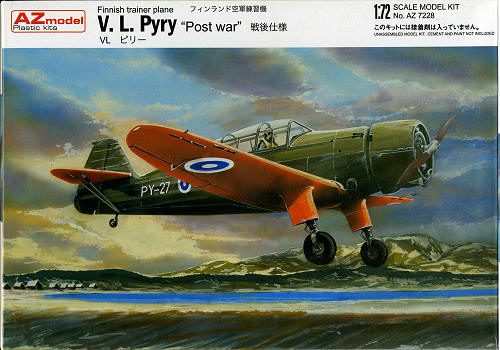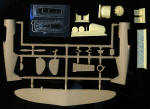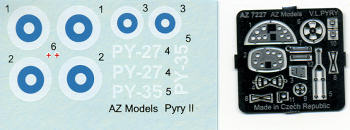
| KIT #: | AZ 7228 |
| PRICE: | $19.85 from www.greatmodels.com |
| DECALS: | Two options |
| REVIEWER: | Scott Van Aken |
| NOTES: | Short run kit with photo etch, resin and vacuformed parts. |

| HISTORY |
VL Pyry was a Finnish low-winged, two-seated fighter trainer aircraft, built by the State Aircraft Factory (Valtion lentokonetehdas) for use with the Finnish Air Force. The Pyry was in use from 1939 to 1962. The aircraft was a mixed construction of wood, steel, fabric, and duraluminium.
The Finnish Air Force ordered a prototype of the aircraft in 1937. It was to be called VL Pyry I and carried the identification number PY-1.
The chief designer was Arvo Ylinen, and the other persons of the design team were Martti Vainio, Torsti Verkkola, and Edward Wegelius.
The first flight was made on March 29 1939 by the factory test pilot, Lieutenant Jorma Visapää. The FAF ordered 40 aircraft in May and the aircraft were quickly constructed and were ready in spring of 1941. These aircraft were known as VL Pyry II and their identification numbers were PY-2 - PY-41.
The first unit to be equipped with Pyrys was the Air Force School in Kauhava, in 1941. The aircraft was used to train pilots for 20 years and it was one of the most successful Finnish airplane constructions. Around 700 pilots were trained in the aircraft and the type accumulated over 56,000 flying hours. The first accident with a Pyry happened in March 1943, when major E.O. Ehrnrooth stressed the aircraft too hard. Ehrnooth, who was the commander of a Messerschmitt Bf 109 squadron, died in the accident.
The last flight with the Pyry was made in Härmälä on 7 September 1962. Captain Veikko Hietamies was the pilot of the PY-1 and senior lieutenant Keijo Elio piloted the PY-27.
| THE KIT |
 Typical
of many short run kits, this one combines a small injected plastic sprue with
photo etch, resin and vacuformed parts. The vac bits are a pair of nicely done
canopies. Always nice to have a spare. Photo etch makes up the instrument
panels, trim wheels, throttle quadrant and one set of harnesses (guess someone
forgot this is a two seat plane).
Typical
of many short run kits, this one combines a small injected plastic sprue with
photo etch, resin and vacuformed parts. The vac bits are a pair of nicely done
canopies. Always nice to have a spare. Photo etch makes up the instrument
panels, trim wheels, throttle quadrant and one set of harnesses (guess someone
forgot this is a two seat plane).  There is a
one piece wing, tail planes, instrument panel backings, interior floor, prop and
tail wheel. Not really a ton of parts, but for a trainer it is sufficient as
these are not complex planes. There are also the lower landing gear forks and a
collector exhaust ring that will fit in front of the resin engine, hiding much
of its generic look. The builder will also have to make control sticks and the
rear tail plane struts. An acetate film has the various instruments which go
behind the photo etch instrument panels.
There is a
one piece wing, tail planes, instrument panel backings, interior floor, prop and
tail wheel. Not really a ton of parts, but for a trainer it is sufficient as
these are not complex planes. There are also the lower landing gear forks and a
collector exhaust ring that will fit in front of the resin engine, hiding much
of its generic look. The builder will also have to make control sticks and the
rear tail plane struts. An acetate film has the various instruments which go
behind the photo etch instrument panels. | CONCLUSIONS |
| REFERENCE |
http://en.wikipedia.org/wiki/VL_Pyry
October 2010
This kit and many other nice kits and accessories can be found at www.greatmodels.com
If you would like your product reviewed fairly and quickly, please contact me or see other details in the Note to Contributors.